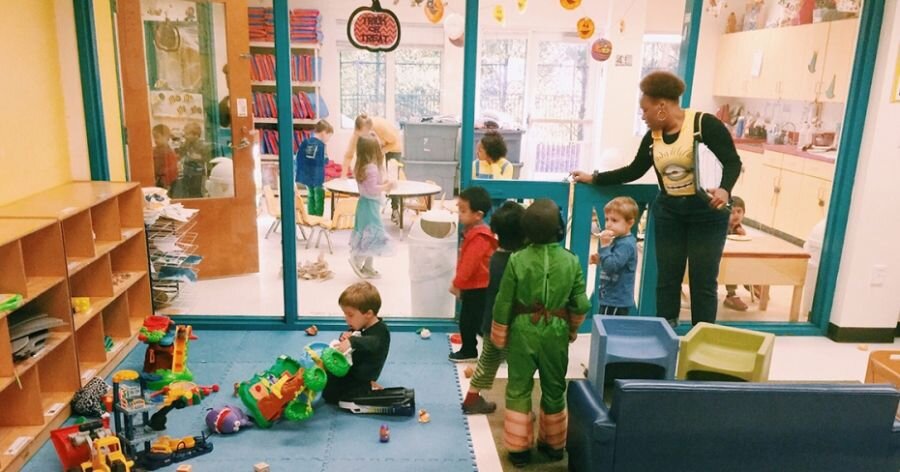Childcare costs in the GTA are nuts and here’s how parents are coping
By: Vin Heney on February 17, 2017
Toronto’s daycare dilemma is reaching a fever pitch.
Thanks largely to a ‘play-in’ at City Hall, recently proposed cuts to childcare funding have been reversed, but many new parents are nevertheless struggling to afford the city’s notoriously skyhigh daycare fees.
A 2016 Canadian Centre for Policy Alternatives study put the average monthly cost for an infant at $1,649. But that’s just the average. If you’re looking to put your infant in a City of Toronto daycare right now — providing you don’t quality for a Child Care Fee Subsidy — you’re facing costs of $106.90 per day, or approximately $2,140 per month.
For most young families, that’s crippling.
So what are new parents doing? Some avoid going back to work (it’s often more economical), while others find more cost-efficient alternatives, such as nanny-shares or part-time childcare arrangements. But for many, finding a spot in a full-time, licensed daycare is still the preferred option.
We spoke to two parents — both single mothers — who found creative ways to navigate the costly world of GTA childcare. Here are their stories.
Emma*
Age of parent: 24
Number of kids in daycare: 1 child (3.5-years-old)
Type of facility: York Region-run
Location: Markham, Ont.
Income: Emma was a student when she first needed daycare (no income), then worked part-time while in school (under $30,000), and is now working full-time ($52,000)
Occupation: Television producer
Current monthly daycare costs: $500 per month for part-time care (3 days/week)
Do you receive a fee subsidy? Yes, while in school. Not currently.
Here’s the situation
As a young, single mom with aspirations to finish school, Emma was suddenly faced with a stifling $1,000 month daycare bill. Not surprisingly, it didn’t fit into her budget. Thankfully, she realized that by returning to school full-time, she qualified for a full-fee subsidy. So, with her son just six-months-old — and with the invaluable support of her parents — Emma found herself back at the books.
“When I first went back to school after having my son, it was actually more affordable for me to pay for tuition than to pay for daycare. So basically by being a single parent and by finishing my degree, my daycare costs were subsidized for five days a week.”
Once Emma finished school, she was again faced with the full-time daycare fees. This time, she opted to only put her son in three days a week, and was fortunate to have her mother look after him for the remaining two days.
LowestRates.ca notes: Part-time daycare in Toronto is often not an option at many facilities, due to the overwhelming demand for full-time daycare spots.
Money woes
Because of her full subsidy, Emma’s financial stress has been less a result of daycare and more a function of being a working parent and sole breadwinner.
“Especially now as I start getting full-time work and getting ahead in my career — and I’m considering my first home, which is insane in the York Region — and you want to save for their education … it’s extremely hard.”
She can’t help but reminisce about the carefree kid-free days.
“Kids put your financial situation in complete disarray. Before, especially as a young person, I went from making my own money, paying my own rent, and having disposable income. Now it’s completely different. Now you’re budgeting, you’re trying to save for education and daycare, and you’re trying to figure out how much to put away before they’re in school and the daycare costs alleviates. So, it’s definitely a point of stress for sure.”
Toronto: take it or leave it?
For many new families, the sky-high daycare costs mean that living in Toronto is simply out of the question.
“I can’t afford to move to Toronto because of the daycare costs — like, I can’t.”
But Toronto was never really an option for Emma, and not just because of the daycare costs. As the heart of Canada’s media landscape, many young professionals look to the big smoke to get a competitive start in the industry, but for new parents who can’t afford the city expenses, it’s simply not that easy.
“Daycares are open from 7:00 a.m. to 6:00 p.m., so I had to think about picking up my son in time. So it wasn’t ‘Oh, I’ll go get a job anywhere.’ Having a child in daycare definitely narrows your jobseeking pool. There would be opportunities I would find online or through friends, and realized they wouldn’t work for me. I can give 100% from nine-to-five, but at 5:00 p.m. I’ve got to go.”
Emma explained how a lot of her friends, many of whom graduated around the same time, don’t have to even think about this. They can stay at the office until [up until 8 o’clock]. Since she finished school, her challenge has been to demonstrate her value and still get home in time to avoid the late pick-up fees (which are laughably high — often around $1 a minute).
Luckily, Emma found an accommodating workplace where she’s not the only parent rushing out at the stroke of five.
Words of wisdom
One thing’s clear: for all of its challenges, making ends meet as a young, single parent yields no shortage of life lessons, money lessons, and everything in between.
“The best piece of advice I got was to ask for help. I think a lot of people in this situation just think ‘well this is the reality of childcare costs and it’s just what we have to pay.’ But there are so many assistance programs in place.”
Emma argues that even if you’re making a decent salary, it’s worth getting yourself assessed to see if you qualify for assistance.
“Even a subsidy for a couple of hundred dollars a month is a couple of hundred dollars a month you’re not spending on childcare. So I would say weigh your options and speak to community services in your area. And if you’re considering a move, look at the communities you’re targeting, look at the daycare costs; it could make a move even that much more enticing. ”
She goes on to make the case for resisting the stigma attached to getting help.
“I think a lot of people associate subsidy with people who are struggling, people who are in down-and-out situations. But you know what — how many of us have OSAP loans? It’s so normalized to get help to pay for school. I don’t think people should feel awkward about asking for that kind of help.”
Michelle*
Age of parent: 37
Number of kids in daycare: 1 child (3.5-years-old)
Type of facility: George Brown College-run
Location: Downtown Toronto
Income: $34,000 + $6,000 child support + Ontario Trillium + GST/HST tax credit + Canada Child Benefit (Total of $44,000 net)
Occupation: Service & Operations Manager for a career management company
Current monthly childcare costs: $120/month (less than 5% of the actual cost)
Do you receive a fee subsidy: Yes. Covers more than 95% of costs.
Here’s the situation
Like Emma, Michelle is a single mother facing the highest daycare costs in the country. But unlike Emma, Michelle is an established professional with no plans of returning to school. So how does she afford the fees? By keeping her salary low.
“In my situation, I would need to take a job earning $60-65,000 at a minimum — $30,000 more than what I’m earning now — to have the same financial situation, because I would lose my child care subsidy and my tax benefits and credits would be substantially reduced.”
She feels that in her situation — four years of college education, no university — it would be very difficult to secure that sort of salary in the career management field.
“It’s not to my advantage to look at other options for employment. For example, if I took a job that paid $40,000 of $45,000 a year, that $10,000 that I seemingly gained is going to go into childcare. And so why bother changing employment when you’re not actually putting any more money in your pocket? It wouldn’t benefit me.”
Money woes
For Michelle, accessing a daycare subsidy is the lynchpin to making it work in Toronto.
“In my situation, I’m not feeling financially stressed. Because I have the subsidy, as long as I can keep the subsidy, my incoming and outcoming moneys are going to be relatively stable. I can afford to pay our bills and actually save money on top of it. The funny thing is, if I was cohabitating with a partner, I would lose all of that and the second income would essentially go towards daycare.”
Toronto: take it or leave it?
Michelle’s work and circle of friends are in the city. But she’s realistic about why she’s able to call Toronto home.
“The only reason I’m able to work and stay in Toronto is the child care subsidy and the child support that we receive from my son’s father. If we didn’t have these two things, we couldn’t afford to stay in Toronto. If I hadn’t secured a childcare subsidy, I probably would have ended up moving back home with my parents in the Owen Sound area.”
And, although she says fees don’t get spoken about often among parents at her son’s daycare, she’s not the only parent faced with tough financial decisions:
“I do overhear from time to time people talking about how much they’re paying for childcare out of their pocket, and it’s usually scenarios where there are two income earners. So it’s actually a good thing that I’m a single mom in that financial sense because they’re only looking at one income with a two-person household. If I had a partner, it would be different. We would be paying the greater portion of childcare out of our pockets. So folks who have their children in the same daycare as my son are paying well over $1,000 per month for their child to be in care. That’s more than rent in a lot of cases.”
Words of wisdom
The thing I would say to new parents is, as soon as you become pregnant, that’s the time you want to be applying for a childcare subsidy in Toronto. Don’t delay applying. I’m very grateful for our subsidy and I really hope that they don’t cut it or limit it more than it already is.
*Names have been changed in this story to protect each woman’s privacy.


